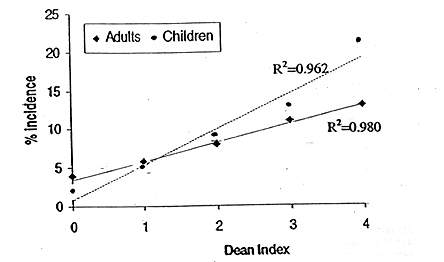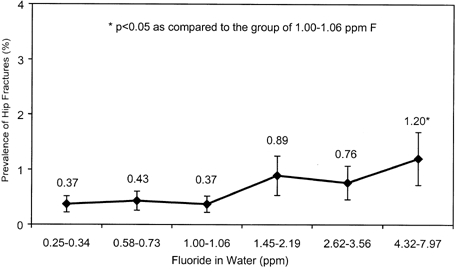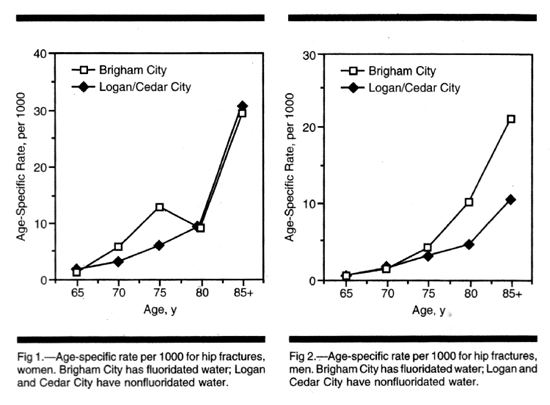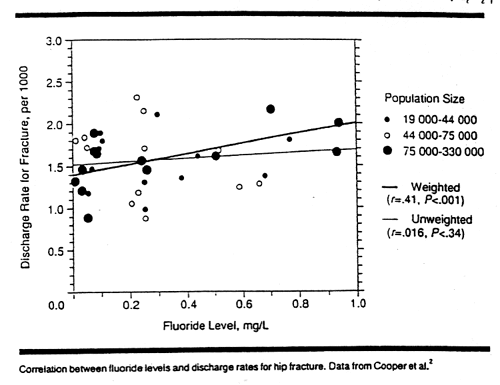HEALTH
EFFECTS: Epidemiology on
Fluoride & Bone Fracture
DIRECTORY: FAN
> Health >
Bone >
Fracture
> Epidemiology
Key
Findings - Epidemiology
on Fluoride & Bone Fracture:
1) Following the publication of several
clinical trials in the 1980s,
where high doses of fluoride
increased the rate of bone fracture among osteoporosis patients,
a flurry of epidemiological investigations were published in
the 1990s investigating the relationship between water
fluoridation and bone fracture.
2) At least 9 studies,
published since 1990, have detected an increased occurrence
of hip fracture among people living in fluoridated (1 ppm),
versus unfluoridated communities. 7 studies, however, have failed
to detect this relationship.
3) The studies reporting a relationship
between fluoridation and hip fracturehave generally been based
on larger populations (a strength), but with less individual-specific
data (a weakness), than studies reporting no association.
4) 3 the 7 studies which failed to find
an increase in hip fracture in fluoridated areas, did find an
increased rate of wrist fracture - a finding
that may relate to fluoride's ability to reduce the density
of cortical bone.
5) According to the National
Research Council, the evidence is sufficient to conclude
that 4 ppm fluoride in water increases the
risk of bone fracture, while the evidence is "suggestive"
that levels as low as 1.5 ppm can increase fracture rates.
6) A study investigating
the relationship between bone fracture and dental
fluorosis, found that the occurrence of bone fracture was
higher among individuals - children and adults alike - who had
with dental fluorosis, and that the risk of fracture increased
with the increasing severity of the fluorosis.
Epidemiology
- Relationship between Dental
Fluorosis & Bone Fracture: (back
to top)
|
|
SOURCE:
Alarcon-Herrera MT, et al. (2001). Well Water Fluoride,
Dental fluorosis, Bone Fractures in the Guadiana Valley
of Mexico. Fluoride 34(2): 139-149. ( See
paper) |
"A linear correlation between the Dean
index of dental fluorosis and the frequency of bone fractures
was observed among both children and adults."
SOURCE: Alarcon-Herrera MT, et al. (2001). Well Water Fluoride,
Dental fluorosis, Bone Fractures
in the Guadiana Valley of Mexico. Fluoride 34(2): 139-149.
Epidemiology
-
High-Fluoride Water (4 ppm+) and Bone Fracture: (back
to top)
Hip
fractures vs Fluoride
Level in Water (China) |
|
SOURCE:
SOURCE: Li Y, et al. (2001). Effect of long-term exposure
to fluoride in drinking water on risks of bone fractures.
Journal of Bone and Mineral Research 16:932-9.
|
"All members of the committee agreed
that there is scientific evidence that under certain conditions
fluoride can weaken bone and increase
the risk of fractures. The majority of the committee concluded
that lifetime exposure to fluoride at drinking water concentrations
of 4 mg/L or higher is likely to increase fracture rates in
the population, compared with exposure at 1 mg/L, particularly
in some susceptible demographic groups that are more prone to
accumulate fluoride in their bones."
SOURCE: National Research Council. (2006).
Fluoride
in Drinking Water: A Scientific Review of EPA's Standards.
National Academies Press, Washington D.C. p. 146.
"In general, the hip fracture prevalence
was stable up to 1.06 ppm of fluoride and then appeared to rise,
although it did not attain statistical
significance until the water fluoride concentration reached
4.32 - 7.97 ppm... The prevalence of
hip fractures was highest in the group with the highest water
fluoride."
SOURCE: Li Y, et al. (2001). Effect of long-term exposure to
fluoride in drinking water on risks of bone fractures. Journal
of Bone and Mineral Research 16:932-9.
"Residence in the higher-fluoride (4
ppm) community was associated with
a significantly lower radial bone mass in premenopausal and
postmenopausal women, an increased rate of radial bone mass
loss in premenopausal women, and significantly
more fractures among postmenopausal women."
SOURCE: Sowers M, et al. (1991).
A prospective study of bone mineral content and fracture in
communities with differential fluoride exposure. American
Journal of Epidemiology 133: 649-660.
Epidemiology
-
Water Fluoridation (~1 ppm) & Hip Fracture: (back
to top)
Hip
fractures in Fluoridated
vs Unfluoridated Areas (USA) |
|
SOURCE:
Danielson C, et al. (1992). Hip fractures and fluoridation
in Utah's elderly population. Journal of the American
Medical Association 268: 746-748. |
Hip
fractures in Fluoridated
vs Unfluoridated Areas (England) |
|
SOURCE:
Cooper C, et al. (1991). Water fluoridation and hip fracture.
Journal of the American Medical Association 266:
513-514. |
"This study examines the geographic
distribution of hip fracture incidence in the United States
at the county level. To this end, data are obtained from the
Health Care Financing Administration (HCFA) and the Department
of Veteran Affairs that identify all hospital discharges with
a diagnosis of hip fracture for women aged 65 years and older
for the period 1984 through 1987...After exclusions, 541,985
cases remained eligible for study... There
is a weak positive association between the percent of county
residents who receive fluoridated water and hip fracture incidence
in the unadjusted analysis that is strengthened after adjustment."
SOURCE: Jacobsen SJ, et al. (1990).
Regional variation in the incidence of hip fracture: US white
women aged 65 years and olders. Journal of the American Medical
Association 264(4): 500-2.
"We found a significant positive correlation
between fluoride levels and discharge rates for hip fracture.
This relationship persisted for both women and men...
Using an appropriately weighted regression
model, there appears to be a positive
ecologic association between fluoride levels of county water
supplies and fracture discharge rates. This
ecologic association is consistent with a recently published
study and others currently in progress."
SOURCE: Cooper C, et al. (1991). Water
fluoridation and hip fracture. Journal of the American Medical
Association 266: 513-514.
" An ecologic study compared fracture
rates in 216 counties with natural fluoride levels greater than
0.7 ppm with rates in 95 counties with naturally low fluoride
(less than 0.4 PPM) in the drinking water. In general, with
increasing dose of fluoride in the drinking water the hip fracture
ratio also increased."
SOURCE: Keller C. (1991) Fluorides in
drinking water. Unpublished results. In: Gordon SL, Corbin SB.
(1992) Summary of Workshop on Drinking Water Fluoride Influence
on Hip Fracture on Bone Health. Osteoporosis International
2: 109-117.
"We found a small but significant increase
in the risk of hip fracture in both men and women exposed to
artificial fluoridation at 1 ppm, suggesting that low levels
of fluoride may increase the risk of hip fracture in the elderly."
SOURCE: Danielson C, et al. (1992). Hip fractures and fluoridation
in Utah's elderly population. Journal of the American Medical
Association 268: 746-748.
"In order to assess
the association between water fluoridation and hip fracture,
we identified 129 counties across the United States considered
to be exposed to public water fluoridation and 194 counties
without exposure...There was a small
statistically significant positive association between fracture
rates and fluoridation. The relative
risk (95% confidence interval) of fracture in fluoridated counties
compared to nonfluoridated counties was 1.08 (1.06 to 1.10)
for women and 1.17 (1.13 to 1.22) for men."
SOURCE: Jacobsen SJ, et al. (1992).
The association between water fluoridation and hip fracture
among white women and men aged 65 years and older; a national
ecologic study. Annals of Epidemiology 2: 617-626.
"The 1985 Fluoridation Census
data were used for the 438 counties with populations over
100,000, which represents about 70% of the US population...
The percentage of the population that received natural or
adjusted fluoride (approximately 1 ppm) was estimated for
each county. Medicare data for 1984-1987 were used to calculate
the annual incidence of age adjusted hip fractures for white
males and females age 65 and older. As
the percentage of individuals exposed to fluoridated water
increased within a county, the hip fracture rate generally
rose for both sexes, but not in a smooth linear fashion...
Adjustment for county latitude and longitude
produced higher correlation values and significance for females
and males."
SOURCE: May DS, Wilson MG. (1992). Hip fractures in relation
to water fluoridation: an ecologic analysis. Unpublished Results:
In Gordon SL, Corbin SB. (1992). Summary of Workshop on Drinking
Water Fluoride Inflruence on Hip Fracture on Bone Health.
Osteoporosis International 2:109-117.
The authors of this study
conclude there is no association between fluoridation and hip
fracture. However, their own data reveals a significant increase
in hip fracture for men living in the fluoridated area. According
to the study, "although a statistically
significant increase in the risk of hip fracture was observed
among Edmonton men, this increase was relatively small (RR=1.12)."
SOURCE: Suarez-Almazor M, et al. (1993). The fluoridation of
drinking water and hip fracture hospitalization rates in two
Canadian communities. American Journal of Public Health
83: 689-693.
"We found a higher risk of hip fractures
for subjects exposed to fluorine concentrations over 0.11 mg
per liter but without a dose-effect relation."
SOURCE: Jacqmin-Gadda H, et al. (1998). Risk factors for fractures
in the elderly. Epidemiology 9: 417-423.
"[A]mong younger women, those aged
50-64 years, higher fluoride levels increased the risk of
hip fractures."
SOURCE: Kurttio PN, et al. (1999). Exposure to natural fluoride
in well water and hip fracture: A cohort analysis in Finland.
American Journal of Epidemiology
150: 817-824.
This study found an age-specific,
statistically-significant relationship between fluoridation
and hip fracture in women 75-84 years old -
RR = 1.43 (95% CI, 1.02-1.84). An increase in hip fractures
was also found in women aged 85 and older, albeit not statistically
significant - RR = 1.42 (CI, 0.98 - 1.87).
SOURCE: Hegmann KT, et al. (2000). The effects of fluoridation
on degenerative joint disease
(DJD) and hip fractures. American
Journal of Epidemiology S18.
Epidemiology
-
Water Fluoridation (~1 ppm) & Wrist Fracture:
(back to top)
This study didn't find an association between fluoridation
& hip fracture, but it did find an association between
fluoridation and distal forearm fracture, as well as proximal
humerus fracture. "Independent of geographic
effects, men in fluoridated areas had modestly higher rates
of fractures of the distal forearm and proximal humerus than
did men in nonfluoridated areas."
SOURCE: Karagas MR, et al. (1996). Patterns of Fracture among
the United States Elderly: Geographic and Fluoride Effects.
Annals of Epidemiology 6: 209-216.
As with Karagas (1996), this study didn't find an association
between fluoridation and hip fracture, but it did find an
association -- albeit non-significant 1.6 (0.8-3.1) -- between
fluoride exposure and elevated rates of forearm fracture.
SOURCE: Feskanich D, et al. (1998). Use of toenail fluoride
levels as an indicator for the risk of hip and forearm fractures
in women. Epidemiology 9: 412-6.
This study actually found a decrease in hip
fractures among those exposed to fluoridation. The average exposure
to fluoridation, however, was only 20 years, and thus the study
may not be relevant to life-long exposure. Also, as with Feskanich
(1998) and Karagas (1996), this study did find an association
between fluoridation and another type of fracture - in this
case, wrist fracture. "There was a non-significant
trend toward an increased risk of wrist fracture."
SOURCE: Phipps KR, et al. (2000). Community water fluoridation,
bone mineral density and fractures: prospective study of effects
in older women. British Medical Journal 321: 860-4.
|





